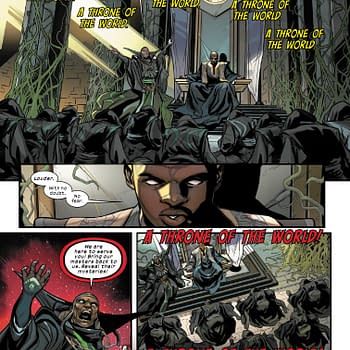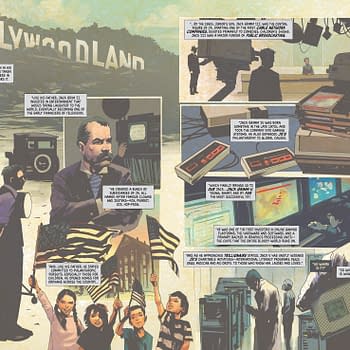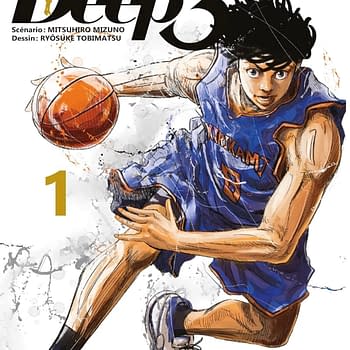Posted in: Comics | Tagged: Comics, dynamite, entertainment, Erik Mona, john carter, jonathan lau, Pathfinder: Worldscape, red sonja
Writer's Commentary: Erik Mona Talks Pathfinder Worldscape #1
A Writer's Commentary: Erik Mona talks Pathfinder Worldscape #1, on sale now from Dynamite. Cover by Reilly Brown, interiors by Jonathan Lau.

I'd seen the scripts, of course, as well as Jonathan Lau's amazing pencils. As the series writer AND the person approving every step of the production as the Chief Creative Officer of the Pathfinder Roleplaying Game, I've had a unique opportunity to see the issue come together at every step along the way. When Jonathan's pencils were given bright life by colorist Omi Remalante, I was the guy looking closely at every panel, careful to make sure that everything looked the way the Pathfinder books said it should, as well as the way it all looked in my head when I wrote it. I carefully checked and re-checked the spelling of every one of Simon Bowland's letters, vigilant for typos. But it wasn't until this Monday, when an early copy of Pathfinder Worldscape #1 arrived in the Paizo offices, that I had a chance to truly appreciate the production as an actual comic book.
Let me tell you, no months-long, piece-by-piece approval process can completely prepare you for reading your own comic for the first time. I thought it would be fun to record my reactions, page by page, and unveil some of the mysteries, Easter eggs, and developments laid out in the first issue here in this article.
There are, of course, a ton of spoilers below. By all means please read the issue itself before you read the rest of this article. Ready? Here we go!

The series opens in the sewers beneath Magnimar, the Pathfinder world's "City of Secrets." That nasty worm-fish battling Seoni the sorcerer, Valeros the fighter, Kyra the cleric, and Merisiel the rogue is Thulgroon, the chief villain from writer Jim Zub's Pathfinder: City of Secrets series from early 2014. Jim launched the Pathfinder comic series and was among the earliest writers to give voice to Pathfinder's "iconic characters," and I'll always be grateful for the fantastic start he gave us in comics.
But like the jungle comic stories of the 1940s I've been reading obsessively to prepare for the series, Jim had a knack for killing off his villains at the end of each of his three Pathfinder story arcs. Thulgroon, a mysterious shape-changing psychic monster called a "veiled master," is one of the few bad guys to survive the early Pathfinder comics, and given that we last saw him turning into a fish and leaping into an underground river over a year ago, I wanted to bring him forward here as a recurring villain, a little peek into the "regular" lives of the Pathfinder adventurers before I rip them from the world of Golarion and throw them into a crazy dimension filled with the greatest fantasy warriors of Twentieth Century Earth.
Spoiler alert: Thulgroon won't be coming with the heroes to the Worldscape, but I want to keep him around for a while to build up the Pathfinders' rogues gallery. He'll be back, if not presently. As we all know from eating at dirty seafood restaurants, you can't keep a bad fish down for long.

This page sets up Thulgroon's psychic powers, which provide one possible explanation for what's about to happen to the Pathfinder adventurers. Are the events of the next six issues simply psychic hallucinations inspired by the veiled master? Is it all just a bunch of "for-fun" garbage that won't have any repercussions or ramifications for the main characters, just like so many other mega-crossover "events"? I certainly hope not, of course, but Thulgroon appears here more or less as an "out" for people who turn up their nose at the idea of all of these properties coming together for a grand adventure. Don't want to believe this could really happen in continuity for all these characters?
Fine. The psychic fish did it.
PAGE 3
The image of Valeros, Seoni, Kyra, and Merisiel struggling against Thulgroon's mental barrage strikes me as a good moment to mention why I chose the Pathfinder characters I did for the Worldscape series. Previous Pathfinder comic arcs have featured six "primary" adventurers, with our two most-recent series (Origins and Hollow Mountain) adding a significant number of back-benchers to compliment (and foil) the affairs of our familiar heroes.

The first of the "core six" Pathfinder characters to hit the cutting room floor was the dwarf ranger Harsk, one of the strongest characters from the three Jim Zub arcs. Jim developed the perfect voice for Harsk, part gruff dwarf and part surprising contradiction—a dwarf more at home in the forest than in the mountain, more comfortable sipping hot tea than throwing back ales in the local tavern. We'd already culled Harsk from the previous arc (for similar reasons, given the huge cast of Pathfinder: Hollow Mountain), so it was easy to keep him off the list for this series, even though I knew a dwarf would add an interesting "high fantasy" element to a comic that otherwise mostly stars humans and full-on monsters. But the deed was already done, so I'm afraid I didn't spend too much time pining for old Harsk. He'll be back in future Pathfinder arcs, of course, and we've been enjoying kicking around ideas of what he's been up to over the last couple arcs when we talk about the series in Paizo's editorial office. Don't despair. We'll get back to him.
The other prominent absence—Ezren the wizard—is a more complicated story (as most of mine tend to be…). My original rough Pathfinder Worldscape outline involved Seoni, Merisiel, Valeros, and Kyra vanishing not from a Magnimar sewer, but from a reception at the Pathfinder Society's annual Grand Convocation in the city of Absalom, world headquarters of the Pathfinder Society adventurer's guild. Ezren would have joined the four other heroes at the reception at the invitation of his boss, Venture-Captain Sheila Heidmarch (another City of Secrets and Origins alum), to present his adventuring journals to the assembled Pathfinders, which would have allowed for an amazing two-page spread absolutely packed with prominent Pathfinder RPG character cameos from the game, the novels, everything.
While Ezren made his presentation, his four companions raised a toast to one another, vanishing just as their glasses clinked together. Ezren would have come back to their room to discover their broken glasses upon the floor, and magical divinations would reveal that his four companions were in fact in a nearby dungeon called the Spire of Nex, where the weird dimension of the Worldscape is physically located about a mile from Absalom.
As the series went on largely as it does in its final version, each issue would focus on a single Pathfinder adventurer manifesting in the Worldscape and interacting with one of the guest stars, learning a bit about heroism from some of the actual heroes who inspired the fantasy roleplaying craze (and thus Pathfinder's "iconic characters") in the first place. After we got a look at issues featuring Valeros, Seoni, Kyra, and Merisiel, we'd snap back to Golarion, where Ezren would assemble a team of Pathfinder Society superstars (definitely including the gnome bard Lem, whom Ezren met in my story in Pathfinder Origins #6) to break into the Spire of Nex from the outside.
Since the very beginning, Ezren has been our main narrative connection to the Pathfinder heroes, with selections from his journals setting the scene for all of the early issues. Of all the Pathfinders, Ezren is the one most interested in being an archetypal hero, and I found the prospect of him NOT getting a ride to the dimension of great heroes very enticing and packed with story potential.
As I said above, though, a comic with a thousand characters is packed with story potential by default, and I grew increasingly concerned as the project neared the execution stage that all of this stuff about what was going on in Golarion during the events of the four heroes' adventures in the Worldscape was potentially a HUGE distraction. The series is called Pathfinder Worldscape, so I wanted all of the action to take place there, not on Golarion. So poor old Ezren found himself not only dis-invited to the Worldscape dimension, but dis-invited to the Pathfinder Worldscape comic itself.
I also worried a bit that a self-indulgent orgy of Pathfinder character cameos was adding insult to injury in a comic already packed with tons of self-indulgent character cameos, so in the interest of everyone's sanity, I had to bench him.
Of the rest of the Pathfinder bunch, only the love-to-hate-him magus Seltyiel and the paladin Seelah were ever under serious consideration. Seltyiel is always a potential inclusion because he's simply so fun to write and he looks cool (good enough criteria in general, but not when the cast is so huge). Seelah I wanted because I also love her look, and frankly because I wanted the comic to feature more than just white dudes. She was originally to appear in a very minor role as one of a group of goodly warriors including the public domain fantasy comic heroes Kalkor and the Golden Knight, but that sub-group of good guys eventually found themselves whittled down to a single panel in the entire series, which wasn't enough reason to bring Seelah along for the ride. At least not this time.
But back to page 3! The third panel, in which Valeros tells Merisiel "You're fading away!" is the last "omniscient" panel in the issue. From that point forward, we're firmly following Valeros.
The fade-out to a field of red, and indeed the use of red at all, is an homage to the "red skies" of DC's Crisis on Infinite Earths maxi-series, the very first mega-crossover comic I ever read as a kid and a cornerstone of my comics fandom.
PAGE 4

Let's start with Gannus, the broken-toothed rogue who opens the scene with his hands in the unconscious Valeros's coin purse. I confess I made this guy up out of whole cloth. For some reason I had David Patrick Kelly's character from the movie The Warriors in my head when I imagined him, and even though I didn't mention the connection explicitly in my script, Jonathan managed to hit the mark effectively. I imagine Gannus is from Earth's Dark Ages, a common criminal trying to make a living for himself by picking off newcomers to the Worldscape and selling their gear at market.
Although future scenes will suggest that the purpose of the Worldscape is to draw in the greatest warriors of three worlds, it's been a long time since the wizard who built the place vanished, and not everyone who is summoned here belongs among the ranks of history's greatest swordsmen. This chump is a good example of some of the errors that have crept into the Worldscape's selection criteria over the years. As the series goes on, we'll be meeting many, many more.
The other two villains here have a comic book pedigree. The red sea-creature Kelgeth is inspired by the "sea-spawn" from Gail Simone's hallmark 2013 Red Sonja arc "Queen of Plagues," which is the benchmark I used for Sonja's characterization throughout the whole Worldscape series. These fish-men were fairly minor to Simone's storyline (their race is not even named), but they are an important part of the visual style of that arc, and I wanted to grab one of them and set him up in an early scene to suggest the sheer weirdness of the Worldscape's inhabitants. At one stage of the issue's development, the four-page Pathfinder RPG rules appendix at the end of the issue was to contain complete Pathfinder rules for creating sea-spawn characters, with different powers based on customizable oceanic physical features like "hammer head" and "coral encrusted." I didn't end up having room for that material (perhaps it will come somewhere else in the future), but I think this race has a lot of promise and Kelgeth was in the Worldscape picture from the very beginning.
De Moire is pulled directly from a 1941's Jungle Comics #13, in particular the Kaanga lead feature. I loved the Satan-beard look of the adventuring French alchemist/explorer, and I thought his French exclamations and the presence of his revolver would serve as an immediate, unsettling example of how Pathfinder Worldscape is a very different type of Pathfinder story than the ones that came before.
I had Kelgeth refer to residents of his era as "Hyborians," though in fairness this isn't quite correct from a canonical Robert E. Howard sense. Of course Howard's Hyborian Age is an ERA and not a world itself, something Red Sonja comics seem to mess up fairly frequently. I reasoned that Earth-people of this era might be known as Hyborians to the folk of the Worldscape, but I'm aware that this reference will probably completely ruin the issue for a few pedants out there. So it goes. I understand that mentality all too well, as I'm not only the president of that demographic, I'm also a member!
PAGE 5

The placement of the Worldscape in the Spire of Nex is honestly kind of a throw-back to the abandoned Ezren storyline I mentioned in my comments on the previous page. It isn't all that important in the grand scheme of things for this first Worldscape series. I hope people enjoy the setting, as I'd like to come back to it some day (perhaps with completely different guest stars!). We merely hint at some of the metaphysical mechanics behind the dimension in this series, but there may be a lot more to explore here in years to come.
References to the city of Shareen and Empress Camilla presage events to come in future issues. The mysterious animal howls coming from the forest depths will resolve themselves somewhat sooner.
I love Jonathan's reaction shot in panel 4. These guys know they don't want to meet the creature making those howls. They needn't worry about it too much, of course, as they never get the chance!
PAGE 6
Pathfinder Worldcape claims its first kill, and it couldn't have happened to a more deserving bastard. Please forgive me for the one-liner. I couldn't resist.
Jonathan's illustration of Valeros in panel 2 is one of my favorites ever drawn of the character. I wanted to portray Val's competence and battle prowess in this scene. While he's nowhere near the same league as legendary heroes like Red Sonja and Tarzan, he's significantly more qualified to be in the Worldscape than the thieves who erroneously considered him easy prey. Oops!
PAGE 7
We get another look at De Moire's pistol. Kelgeth's reference to Valeros being "strong as a Cimmerian" is an homage to another great Robert E. Howard character who probably belongs in the Worldscape, but who remains protected from abduction by Dynamite not having the license. Maybe one day!
PAGE 8
When we started the Pathfinder comic line about 5 years ago, I think none of us ever imagined that the line "Mon Dieu, the pain!" might appear in one. Here's to pleasant surprises!
I'm not quite so wordy commenting on these Jonathan Lau action scenes. His kinetic art speaks for itself.
PAGE 9
My description of panel 1, from the script: "Valeros swings his short sword into the back of the kneeling De Moire's skull, sinking it in half-way, like a machete cutting into a watermelon. De Moire's eyes are wide open in surprise."
Nailed it!
Killing an enemy by throwing a sword, something that's actually pretty difficult to do in the Pathfinder RPG rules, is such a staple of goofy sword & sorcery movies that I couldn't resist including the trope here, even though I kind of hate it. As usual, Jonathan takes one of my mediocre ideas and draws it in a way that completely masks its inherent lameness. Thanks, Jonathan!
PAGE 10
This splash page of Valeros fighting a four-armed Barsoomian White Ape is probably the very first image I ever imagined once it started to look like Pathfinder Worldscape was going to become a reality. Fantasy RPGs have had plenty of knock-off White Apes, but you've gotta go to the source to get the real thing. I still can barely believe I pulled this whole thing off, folks.
PAGE 11
I really love writing Valeros. He's got just the right combination of humor and action to make for a fun action scene, and I relished the opportunity to give him a few lines about getting his ass kicked by a monkey. He'd better watch his tongue when it comes to making fun of or mis-identifying apes. That could turn into a real problem for him starting next issue, when Golarion's Gorilla King Ruthazek comes to the Worldscape.
But I'm getting ahead of myself…
PAGE 12
Hooray! A barrage of gunfire comes to the rescue to save Valeros from the clutches of the murderous ape! But perhaps these are not the rescuers he would have chosen. The rifle-wielders are Holy Therns, hairless white Martians associated with Barsoom's cult of Issus, Goddess of Death and Life Eternal. The Therns are the principle enemy in Edgar Rice Burroughs's second John Carter novel, The Gods of Mars, which happens to be one of my favorite fantasy novels. They also feature in several Dynamite Warlord of Mars arcs, notably the second volume, which is largely an adaptation of the Gods of Mars plot.
In the novel and the comic, the Therns wear elaborate get-ups complete with long blond wigs, capes, and gilded harnesses. I wanted to see Therns who had been in the Worldscape for years and years, bereft of their finery, their gorgeous wigs a thing of the past. Drawing in countless cutthroats as it does, the Worldscape is a perfect holy site for the death-worshiping Therns, and we'll be hearing a lot more from them in future issues (particularly #3).
The snake-bodied leader of the Thern hunting party is the lamia matriarch Xanesha, one of the most feared and hated villains of the Pathfinder Roleplaying Game. Xanesha appeared in Paizo's Rise of the Runelords campaign, the first-ever Pathfinder Adventure Path, where she managed to kill hundreds of player characters in the years since her original 2007 appearance. I added her to the comic as an Easter Egg for Pathfinder players, and (again) to beef up the Pathfinder comics rogue's gallery. Because translating the entire 500-page Adventure Path to comics would take at least 36 issues and Dynamite prefers shorter series of 5 or 6 issues, we'll probably never do a full-on Runelords adaptation. If we do, Xanesha will be a big part of it. I've come to appreciate her as a comic book villain over the last few months of writing Worldscape, so it's likely she'll re-appear in the comic at some point, Runelords adaptation or otherwise.
PAGE 13
More Xanesha on this page. Notice the sihedron rune tattoo on her forearm in the bottom left panel. This is a call-back to Pathfinder: Hollow Mountain, the comic series immediately preceding Worldscape. In that series (which I co-wrote with F. Wesley Schneider and James L. Sutter), the Pathfinders went up against Alaznist, the Runelord of Wrath. Xanesha serves Karzoug, Runelord of Greed, the chief villain of the Rise of the Runelords Adventure Path campaign, and the sihedron rune is their symbol of the evil Runelords collectively. It's plastered all over the Hollow Mountain dungeon explored in that series, and will certainly be reappearing in future story arcs.
Xanesha's mention of Shareen's Arena, in the second panel, is the first reference to what will become one of the most important locations in the Pathfinder Worldscape series. Xanesha "recruits" and trains the gladiators of the arena for the enjoyment of the city's brutal denizens, and she'll reappear in a significant way in issues 3, 4, and 5.
"Camilla's new alliance" that Xanesha mentions here is an association with the Gorilla King, Ruthazek, another of Golarion's arch-villains, who makes his series (and comic book) debut next month in Pathfinder Worldscape #2.
PAGE 14
The sound effect of Xanesha whipping Valeros is meant to carry over from the crack of the Thern's gun on the previous page. I'm not certain sound effect-based scene transitions work particularly well in comics, but I had to give it a shot.
As we get closer and closer to the action at the bottom of the page, the whip-cracks echo over images of the city of Shareen, at the center of the Worldscape's jungle. Shareen comes directly from Frank Frazetta's 1952 jungle hero comic Thun'da, which I'm somewhat afraid to admit I fell in love with while researching public domain characters to add to the Worldscape cast. Even though the comic was sub-titled "King of the Congo" (also the name of a stultifying Buster Crabbe multi-part serial loosely based the hero), Frazetta had the good sense to have his white man crash land his plane in a lost valley filled with cave men and dinosaurs. That allowed him to play with some of the tropes of jungle comics without delving too deeply into issues of colonialism, slavery, and outright racism, traps most other jungle comics of the era simply couldn't resist. Frazetta only lasted a single glorious issue, and after that editorial fiat ensured that Thun'da would become just another run-of-the-mill jungle hero mired in the same gross ethical goo as the rest of them. For that one, beautifully drawn issue, though, Thun'da was glorious. I frankly like Thun'da more than Tarzan, as his out-sized role in issues to come will likely soon make clear.
Thun'da himself doesn't appear until next month, but two staples of his early stories do make it through, the first being Shareen itself. I decided to incorporate Thun'da's entire "Dawn World" setting into the Worldscape, complete with his allies, villains, dinosaurs, and ruined cities. We'll be seeing a lot more of this stuff as the series continues.
PAGE 15
Xanesha tells Valeros a bit about Empress Camilla's "Tournament of Death" (a phrase borrowed from the original 1930s tales of another Dynamite hero who ALMOST appeared in the series), complete with a clumsy turn of phrase by yours truly that adds some unnecessary confusion to the series timeline. By "the final tournament is tomorrow," what Xanesha MEANS to say is that the final battle to determine who will serve as Camilla's ceremonial Scepter-bearer is tomorrow. The actual final tournament, in which Camilla's champion battles an as-yet-unrevealed enemy, is actually the day after THAT. On reading this a second time, I wish I'd been a little more clear on that point. Sorry!
PAGE 16
Here we have the second major Thun'da element of the issue, Queen Pha, who essentially serves as Thun'da's girlfriend in the original 1950s stories. The queen of a lost civilization trapped in the Dawn World, Pha eventually joined up with Thun'da on numerous adventures during his run. Her costume was designed by Frank Frazetta. I cannot fathom why lesser artists (hey, I like Thun'da follow-up artist Bob Powell a lot, especially for his spin-off character Cave Girl, but he's no Frank Frazetta!) monkeyed with Pha's costume shortly after Frazetta left the book, but they did, and she ended up losing a lot of her distinctiveness. I really like her. She's an unusually strong and capable woman warrior from 1950s comics, especially 1950s jungle comics. Maybe I'm reading into it too much because I like her look and because she's depicted as a capable leader rather than just arm-candy and kidnap bait, but I'm happy to give her more exposure here in Pathfinder Worldscape.
I had to make Valeros shirtless in at least one scene in the comic. So many of these Dynamite and public domain heroes spend their time pretty close to naked, so I thought it only fair to return the favor.
The "good man" who once ruled Shareen at Pha's side is Thun'da, of course.
PAGE 17
The third panel of this page has a significant coloring mistake that I sadly overlooked during the issue's production. The two guys wearing helmets and shouting about how "death by spear pays twice my wager" are supposed to be red Martians from Barsoom. They look totally fine as white guys, sure, but my failure to catch this will probably haunt me forever. Or at least until I try to get Dynamite to fix it in the collected edition.
The current ruler of Shareen is Empress Camilla, an obscure jungle hero from 1940's Jungle Comics #1. Like a lot of comics of the era, Jungle Comics was a huge 60-page collection of several short stories featuring numerous different characters. The blond jungle lord Kaanga was the lead feature, but there were tons of others, including at least a small handful with significant roles in Pathfinder Worldscape. Camilla, in some ways the chief villain of the series, is the second-most important Jungle Comics hero to appear in the series (the MOST important being Fantomah, who appears in the next issue).
It's actually a bit of a stretch to call Camilla a hero at all, since her "Camilla, Queen of the Lost Empire" Jungle Comics series portrays her as a full-on villain, an immortal monarch descended from an ancient tribe of Vikings who somehow settled in the African jungle and who created a fantastic city-state filled with weird magic and technology. By her second appearance, Camilla got a different costume and somehow changed into a relative of Ghengis Kahn, but she was no less a villain (if anything, she's even meaner in her second appearance). Her third appearance shifts back to the original take, and slightly redeems her character. After that she has a short period as an ass-kicking, sword-wielding Viking adventurer before eventually becoming a run-of-the-mill blonde jungle girl whose most interesting element is that she wears a zebra-print bikini. Those early jungle comics started with some amazingly fresh characters and ideas, but eventually editors managed to ruin pretty much everything interesting about them, churning out Tarzan and Sheena clones by the dozens. So it goes.
But for a few issues early in her career, Camilla was something truly interesting, and that's the version I've chosen to preserve and present in Pathfinder Worldscape.
PAGE 18
More fighting in Shareen's Arena. Panel 6 is the first of many in the series in which I challenged Jonathan to fill the panel with scumbags and reprobates from a variety of worlds, and I love what he did with it. The red dude with the big nose is my favorite.
PAGE 19
And here, at last, we have the introduction of one of Pathfinder Worldscape's major guest stars—Red Sonja. I couldn't resist having her introduce herself by using her logo in place of her name, one of my favorite corny comic book tricks.
I'm not sure I love Sonja's comment in panel 3 of this page. I read a LOT more Red Sonja comics after I finished this script than I had before, and I feel like I have a better handle on her voice in future issues.
PAGE 20
I get a kick out of having these two fight each other, because in fact they are very similar characters who, under different circumstances, might be great drinking buddies. Alas, that doesn't seem to be the plan the Worldscape has for them.
In Pathfinder RPG terms, Valeros at this stage is about 6th level. Red Sonja is more like 8th. She's definitely a stronger, more experienced combatant. I tried to show this by depicting her on the offense in almost all these panels, whereas Valeros is doing his best just to stay alive.
There are a lot of references to Camilla's Scepter in this issue. Much more on this topic will be revealed in issue #2.
PAGE 21
Wait, what is Valeros's companion Merisiel doing hanging out with the bad guys? I'll bet there's an interesting story behind that! I knew I wanted the issue to end the way it does from the moment I sat down to write it. Merisiel's strange bedfellows in this scene, and Valeros looking up to take it all in, provided me with just the distraction I needed to set up the final splash page…
PAGE 22
Poor, poor Valeros. I knew right away that I wanted to ultimately pair up Valeros with Red Sonja, and that I wanted her to thoroughly kick his ass. And, thanks to a stunning panel drawn by Jonathan Lau, I'd say she more than followed through on my plan.
EVERYTHING ELSE
In addition to 22 pages of story, Pathfinder Worldscape #1 contains official Pathfinder RPG game stats for Red Sonja and a new "sword-devil" ranger archetype that can be used to create similarly armored and powered characters of your own design. I've already rambled on enough about the issue proper in this space. If you're interested in a similar look at the Pathfinder rules design element of Worldscape, please check out my weekly Paizo.com "Worldscape Workbook" column (http://paizo.com/paizo/blog) for a weekly peek into my design process. If you've made it this far, you'll probably enjoy following that blog, or following my general ramblings on Twitter @erikmona. See you over there!














